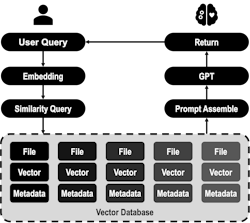Using GPT AI with BIM Models: A Comprehensive Approach to Revolutionize Building Management
BIM provides a rich digital representation of the physical and functional aspects of a building. It is a game-changer, but what if there were ways to make this complex information even more user-friendly? This is where Artificial Intelligence (AI), particularly Generative Pre-training Transformer (GPT), enters the picture.
A Two-Layered AI Approach to BIM
While BIM has undoubtedly revolutionized building management, understanding it can often seem overwhelming for non-technical staff such as facilities managers or building owners. Integrating GPT AI with BIM can bridge this gap by creating a system where natural language queries can be used to interact with the BIM model. However, this integration is not straightforward.
Feeding an entire BIM model, often structured as a lengthy JavaScript Object Notation (JSON) file, directly to GPT would not only be costly but also impractical due to AI’s limitations. Moreover, GPT might not understand what the different elements represent, as it is primarily trained on text content.
To overcome these challenges, a two-layered AI approach is proposed. The first layer involves GPT AI, which excels at interpreting the user’s intent from their query. For instance, if a user asks, “Where is the supply air system?” GPT AI interprets this request as a desire to highlight all elements related to the supply air system in the BIM model.
The second layer involves a different AI, specifically trained to interact with BIM models. This AI takes the interpreted request from GPT AI and performs the actual query on the BIM model, ensuring accurate and effective data retrieval. A highly conceptual diagram is illustrated in Figure 1.
Beyond BIM Models: Exploring the Potential of AI in Building Operations and Maintenance
The potential of AI in building management extends beyond just directly working with BIM models. Building Operations and Maintenance (O&M) involves utilizing numerous procedures, manuals, and instructions for different assets. These can also be efficiently managed using AI when querying the BIM model.
Imagine being able to ask an AI system, “How should AC unit model XYZ be maintained?” and receiving an instant response with precise instructions from the corresponding maintenance manual. However, since GPT AI has a knowledge cut-off and is not continuously updated, it cannot provide answers to questions about data or specific building data introduced after a certain date. Additionally, constantly updating AI with all these documents and knowledge to fine-tune the model is both time-consuming and expensive.
Embracing Emerging Technologies: Embeddings and Vector Databases
Applying these technologies to building management can convert all the building’s documents and instructions into a vector form and store them in a vector database. This allows GPT AI to perform quick and efficient searches, providing accurate, relevant information on demand. This is shown in Figure 2. While the intricacies of these technologies and their application warrant a more extensive exploration, the transformative potential they hold for building management is evident.
Case Study: Harnessing AI and BIM
Visualize the transformative potential of integrating AI with BIM models and employing emerging technologies through a scenario featuring a seasoned facilities manager of a commercial building.
Recognizing the power of AI and BIM, the facilities manager adopts an integrated AI system for efficient building management. When a query regarding the maintenance of the HVAC system arises, there is no need to navigate through complex BIM models or consult with technical experts.
The next step is to simply pose the question, “How can the second floor HVAC system be isolated?” to the AI. The GPT AI, serving as the first layer, interprets the query, and the second layer AI, trained to interact with BIM models, retrieves the necessary data from the model. The manager gets a precise answer almost instantaneously, enabling swift, data-driven decisions.
The same facilities manager, also responsible for the building’s O&M, faces the challenge of picking the proper procedure from numerous asset-specific documents. Fortunately, all the building’s O&M documents have already been digitized, converted into vectors and stored in a vector database.
So, when there is a need to know, “What are the recommended maintenance procedures for this selected HVAC unit?” the next step is to simply ask the AI. The AI, powered by GPT, interprets the query, searches the vector database and quickly provides the necessary maintenance procedure, saving considerable time and effort.
This integrated scenario showcases the immense potential of combining GPT AI with BIM and utilizing the power of emerging technologies. Such an approach significantly simplifies building management, making it more accessible and efficient and paving the way for a comprehensive, user-friendly future in managing built environments.
Conclusion
The integration of GPT AI with BIM signals a new era in building management. This collaboration not only makes BIM more accessible to a broader audience but also transforms management and maintenance of buildings, enabling a more efficient, user-friendly interaction with complex building data.
By enabling natural language interaction with BIM models and other crucial documents, it democratizes access to essential data, making building management more engaging and intuitive. As AI and other emerging technologies continue to be embraced, they bring closer a future where buildings are not just structures, but responsive entities that communicate and interact with facilities management in a meaningful way. The future of building management is indeed exciting and promises endless possibilities.
About the Author
George Broadbent
George Broadbent is Vice President of Asset Management, Symetri. Prior to his current role, George was Director of Asset Management. He has more than 25 years of diversified professional experience in Asset Management, Electronic Content Management, System Architecture and Vital Records Planning and Management.


